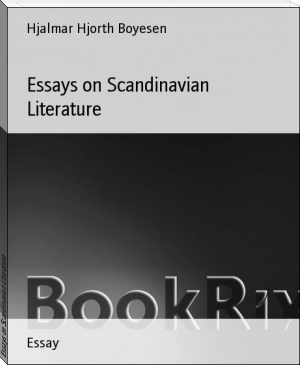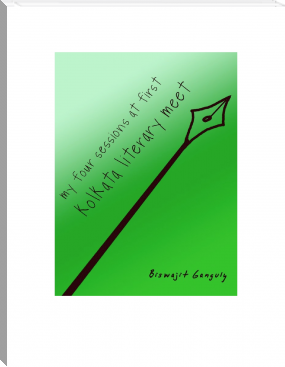Essays on Scandinavian Literature by Hjalmar Hjorth Boyesen (e book reader online .txt) 📖

- Author: Hjalmar Hjorth Boyesen
Book online «Essays on Scandinavian Literature by Hjalmar Hjorth Boyesen (e book reader online .txt) 📖». Author Hjalmar Hjorth Boyesen
"Well, then," he continues, "from this fountain will I drink, if I am worthy of such a draught. With healthy eyes will I look about me in the sick world. My golden lyre shall not resound with sorrows which I myself have invented. For the poet's sorrows are none; and the sky of song is forever bright."
Peter Amadeus Atterbom, the leader of the Phosphorists, replied with much moderation and good sense to the obvious reflections upon his school which this poem contained. He intimates plainly enough that Tegnér's philosophy of life, in so far as it ignores sin and sorrow, which are too real to be banished by song, is a hopelessly shallow one.
"The undissolved dissonances," he says, "in the sense in which Mr. Tegnér uses the expression, certainly betray a disease of the soul, but this disease is not peculiar to a temperament which is fostered by a personal emotional affinity for lugubrious topics and ideas given by birth and developed by circumstances; but it is inherent in the weakness (which at times doubtless surprises even the strongest ...) of desiring to set up its sorrowful view of the world as a theory, and treat it as absolutely true and fundamentally valid for all. Sorrow, as such, is no more a diseased state than is joy; both are alike primordial, necessary, indispensable elements and halves of human life. Who would venture to assert that the day might dispense with the night? And does not the latter's glorious starry sky rival in majesty (though different in kind) the former's bright and dazzling blitheness?"
The fact was that Tegnér's cheery sun-worship was as much temperamental as was Atterbom's sentimental reveries and nocturnal melancholy. The Phosphorist is unquestionably right, however, in asserting that as a theory of life the one is as limited and imperfect as the other. It was because of the abhorrence of all the darker phases of existence that Tegnér's bright Hellenic muse never struck those notes which thrill with deepest resonance through the human heart. Tegnér's acquaintance with suffering during the early part of his career was chiefly a literary one, and like Goethe he went far out of his way to avoid the sight of it. As there can be no victory without combat--no laurel without dust--the Mount of Transfiguration is not reached except through the valley of the Shadow of Death.
There are, however, many fair flowers to be plucked in Tempe and the blooming vales of Arcady. Goethe had in 1798 published "Hermann and Dorothea," the form of which was Greek, though the theme was Teutonic; and Tegnér's "Children of the Lord's Supper" (1820), which Longfellow has translated so admirably into English, derived its inspiration primarily from the German idyl:
"Pentecost, day of rejoicing, had come, the church of the village
Stood, gleaming white in the morning sheen. On the spire of the belfry,
Decked with a brazen cock, the friendly flames of the spring sun
Glanced like the tongues of fire beheld by Apostles aforetime."
Thus run the beautiful, stately hexameters, which, whatever cavilling critics may say, are delightfully adapted for epic narrative in any fairly polysyllabic language. And Swedish, which is the most sonorous of all Germanic tongues, and full of Gothic strength, produces the most delectable effects in the long, rolling line of slow-marching dactyls and spondees. The tempered realism of Tegnér, which shuns all that is harsh and trite, accords well with the noble classical verse. He employs it, as it were, to dignify his homely tale, as Raphael draped the fishermen of Galilee in the flowing robes of Greek philosophers. The description of the church, the rustic youth, and the patriarchal clergyman has, however, the note of experience and the touch of earth which we miss in the more declamatory passages. If, however, declamation is anywhere in place it is in the three orations of the rural parson, which occupy the larger portion of the poem. It is all very lovely and edifying; full of sacred eloquence and a grand amplitude of phrase which is distinctly clerical.
The romantic tale of "Axel" (1822), modelled after Byron's narrative poems, rejoiced in a greater popularity, in spite of the carping criticism with which it was received by the _Svensk Litteratur-Tidning,_ the organ of the Phosphorists. Though, to be sure, the merits of the poem are largely ignored in this review, it is undeniable that the faults which are emphasized do exist. First, the frequent violations of probability (which, by the way, ought not to have been so offensive to a romanticist) draw tremendous draughts upon the reader's credulity; and secondly, the lavish magnificence of imagery rarely adds to the vividness of the situations, but rather obscures and confuses them. It reminds one of a certain style of barocque architecture in which the rage for ornamentation twists every line into a scroll or spiral or arabesque, until whatever design there originally was is lost in a riot of decoration. The metaphors exist for their own sake, and are in nowise subordinate to the themes which they profess to illustrate. Take, for instance, the oft-quoted passage:
"The night drew near, and in the west
Upon its couch lay Evening dreaming,
And silent, like the priests of Egypt,
The stars pursued their radiant paths,
And earth stood in the starry eve,
As blissful as a bride who stands,
The garland in her dusky hair,
Beneath the baldaquin and blushes.
Tired of the games of day, and warm,
The Naïad rested, still and smiling,
The glow of evening shone resplendent,
A gorgeous rose upon her breast;
And merry Cupid, who had slept
When sun was high, awoke and rode
Upon the moonbeams up and down,
With bow and arrow, through the forest."
This is all very magnificent; but the images tread so close upon each other's heels, that they come near treading each other down, and tumbling together in a confused jumble. I claim no originality in calling attention to the fact that it must have been a colossal Naïad who could wear the evening glow like "a gorgeous rose upon her breast." Likewise former critics have questioned whether the stars gain in the least in vividness by being compared to the priests of Egypt,[31] who were certainly far less familiar to the reader's vision.
[31] L. Dietrichson: Indledning i Studiet af Sveriges Litteratur. Kjöbenhavn, 1862. See also Svensk Litteratur-Tidning as quoted in B. E. Malmström: Grunddragen af Svenska Vitterhetens Historia, vol. v., p. 423. Oerebro.
The story of the Swedish officer Axel and his beloved, the Cossack Amazon, Maria, has from beginning to end a flavor of Byron, and recalls alternately "the Corsair" and "Lara." The extravagant sentimentality of the tale appealed, however, powerfully to the contemporary taste, and the dissenting voice of criticism was drowned like the shrill note of a single fife in the noisy orchestra of praise. The Swedish matrons and maidens wept over Axel's and Maria's heroic, but tragic love, as those of England, nay, of all Europe, wept over that of Conrad and Medora. Maria, when she hears that Axel has a betrothed at home, enlists as a man in the Russian army (a very odd proceeding by the way, and scarcely conducive to her purpose) and resolves to kill her rival. She is, however, mortally wounded, and Axel finds her dying upon the battlefield.
"Yea, it was she; with smothered pain
She whispers with a voice full faint:
'Good-evening, Axel, nay, good-night,
For death is nestling at my heart.
Oh! ask not what hath brought me hither;
'Twas love alone led me astray.
Alas! the last long night is dusking;
I stand before the grave's dread door.
How different life, with all its small distresses,
Seems now from what it seemed of yore!
And only love--love fair as ours,
Can I take with me to the skies.'"[32]
[32] The original is in the rhymed Byronic metre, mostly in couplets. In order not to sacrifice anything of the meaning I have chosen to put it into blank verse.
This is exactly the Byronic note, which would be still more audible, if I had preserved the rhymed couplets. Even Medora's male attire is borrowed by Maria, and much more of this Byronic melodramatic heroism is there, only a little more conventionally draped and with larger concessions to the Philistine sense of propriety. But even if Tegnér in "Axel" had coquetted with the Romantic muse, it would be rash to conclude that he contemplated any durable relation. The note which he had struck in his renowned oration at the festival commemorating the Reformation (1817), came from the depth of his heart, and continued to resound through his speech and song for many years to come. I do not moan to imply, of course, that the Byronic Romanticism was very closely akin to that of Tieck, the Schlegels, and Novalis; or that Tegnér in the least compromised his frank and manly liberalism by composing a variation, as it were, on a Byronic theme. How deeply he hated the mediæval obscurantism which then, under the auspices of Metternich and his unholy "Holy Alliance" was spreading over Europe, he showed in numerous private and public utterances concerning the political condition of Europe after the fall of Napoleon. His greeting to the "New Year, 1816" (which his son-in-law has foolishly excluded from his edition of the collected works), is overbrimming with bitterness at the triumph of the enemies of the light.
"Hurrah! Religion is a Jesuit,
The rights of man are Jacobins;
The world is free; the raven is white;
Long live the Pope--and that other;
I am going to Germany, and there I'll learn
Sonnets to sing and incense to burn.
"Welcome, thou New Year, with murder and gloom,
Stupidity, lies, and fraud!
I hope thou'lt make an end of our earth,
A bullet at least she's worth;
She's restless, poor thing, like many another,
A shot through the head--she'll cause no more bother!"
It was the fashion in those days to revile the Revolution, because it had produced the man on horseback who had turned the old order of things topsy-turvy in a very unceremonious fashion.





Comments (0)